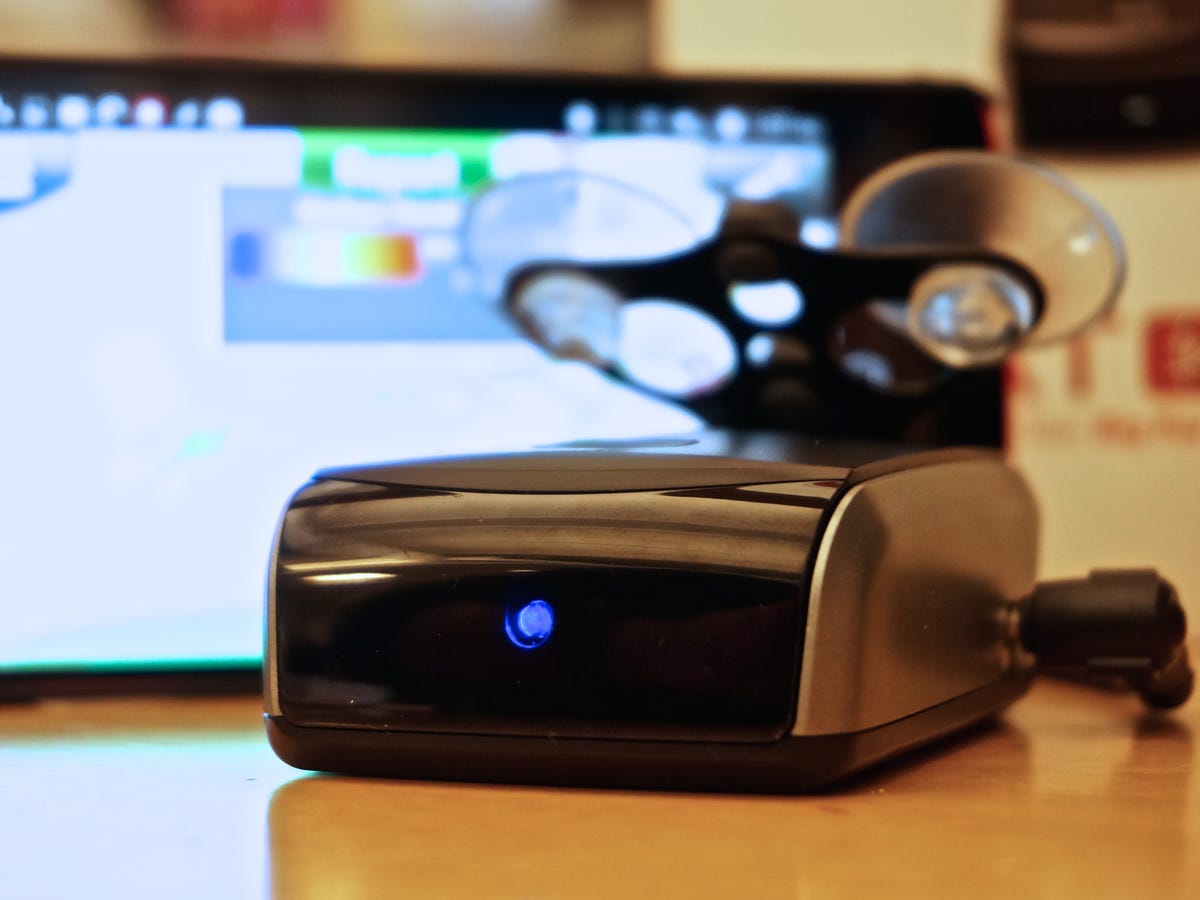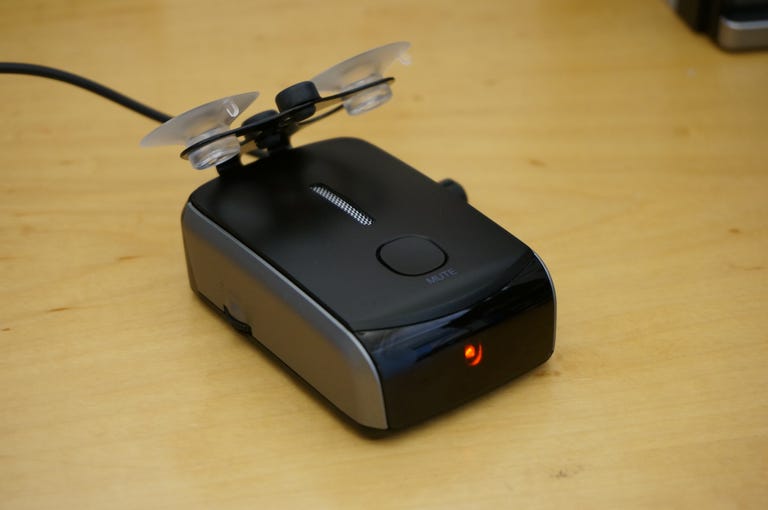 Why You Can Trust CNET
Why You Can Trust CNET Cobra iRadar Atom (iRAD 900) review: App-augmented Atom is big on radar detection performance
This radar detector teams up with your smartphone to help save you from speeding tickets.
The Cobra iRadar Atom (iRAD 900) builds on the previously tested iRAD 200 , cramming everything that we liked about the old hardware into a smaller, less obtrusive package. The tiny device has a footprint that's smaller than a deck of cards (3.34 inches by 2.21 inches), though at 1.15 inches deep, it is a bit thicker. Designed to sit atop your dashboard without attracting attention, the Atom is finished with a combination of glossy and matte-black plastic with dull silver side panels.
The Good
The Bad
The Bottom Line
Behind a semi-transparent black plastic panel on the front of the device that points toward the front of the vehicle when mounted on the windshield, you'll find the radar and laser sensors. On the back of the device, the end that faces the driver, is a small multicolor LED and more radar/laser sensors. The LED glows red when the Atom is powered on and changes to blue when your phone is paired via Bluetooth. We'll come back to this bit shortly.

A small speaker can be found on the top of the radar detector behind a mesh grille and just afore of a large mute button. On the left side of the device is a volume toggle that doubles as a power switch, and on the right side is an input for the power supply.
Speaking of power, the iRadar Atom ships with and is powered via an adapter that plugs into your vehicle's 12-volt power point. The adapter features an integrated USB port (5V, 1A) that allows you to plug in and keep your phone juiced. The iRadar doesn't include a Micro-USB or Lightning cable, so you'll need to bring your own.
Flipping back around to the front of the detector, a double suction-cup mount slides into a slot on the back of the device and allows it to hang from the windshield glass. This is the same double bracket that we found packaged with the iRAD 200, but it now features better suction cups made of a more pliable clear plastic that sticks to nonporous surfaces. Better suction is quite important for the sort of, ahem, spirited drivers who would need the abilities of a radar detector.
The detector and the app
The iRadar Atom is sensitive; perhaps too sensitive, but you've got some control over that. Early on in my testing, the detector would beep "radar equipped" for speed limit signs up to a quarter-mile down the road. It beeped for grocery stores' automatic doors before I was on the same block. It would beep for pretty much everything. With each alert, the iRadar would speak aloud the type of radar that it was detecting ("Ka band" or "K band") and then beep, varying the volume and intensity based on the strength of detection, until I was out of range or tapped the Mute button.
All of that beeping could get annoying. That's where the Cobra iRadar app comes to the rescue.
After installing the app on your iOS device or Android phone and pairing the phone with the Atom via Bluetooth, the driver allows the driver to teach the detector hardware the difference between false alarms (speed-limit signs) and true threats (police clocking speed on the other side of the hill). When you get a false alarm, the software will remember the GPS position, radar band, and frequency, and eventually learn to ignore subsequent alerts of that type.
Armed with the information about the type of alerts (band, frequency, strength, more) that you're getting, the app allows the driver to customize the behavior of the iRadar detector. For example, if you're getting a lot of X band alerts in an area where you know the police typically use the K and Ka bands, you can simply disable all X band alerts for a more quiet ride. You can disable voice prompts and be alerted only with beeps.
Also built into the app is Cobra's AURA database of peer-reported hazard warnings, speed trap alerts, camera alerts, and more. When a driver gets a radar alert, he or she is also able to confirm Live Police presence by tapping a large button in the app, which uploads the location of the alert to the AURA database to be shared automatically to other Cobra users. Much like how peer-reported traffic info in an app like Waze gives drivers information about jams that are miles up the road, the network of Cobra AURA reports gives drivers information about speed traps well outside of the limits of the detector's range. These alerts sound via the iRadar's speaker as you approach their GPS location just like locally detected alerts -- for example, "red light camera ahead" or "hazardous area ahead" -- keeping the driver informed without taking their eyes off of the road.
The benefits of the iRadar app and the AURA database happen automatically, the user doesn't need to touch or look at the phone, merely pair it and let the app run while you drive. Users who want to take a more active approach can also quickly make manual reports, marking the locations of hazards, cameras, and police with as few as two quick taps.
Over the course of a week, the app and the device had learned the false alarms around my area and drastically reduced the number of false alerts reported while I was running errands or driving about.
Additionally, the iRadar app has a few functions that increase its helpfulness when on the road and when not. When the app disconnects from the hardware, it marks the GPS location of your parking spot to help you get back to your vehicle later. The app can overlay audio controls onto its map interface to allow quick play, pause, and skip, give rudimentary point to point directions, and give a bird's eye view of the traffic on the road.
Not so fast
The iRadar Atom's reliance on the smartphone app is both its biggest strength and a potential weakness. Aside from volume and mute, the Atom has no physical controls. There's no display aside from the red/blue LED. It will function without your phone, but without the app telling it what to do, there is decidedly less finesse to how it handles false alarms.
The iRadar pairs with your phone via Bluetooth and your phone probably also connects to your car's hands-free calling system via Bluetooth as well. Most phones won't have a problem maintaining pairings with two devices, but those who also use fitness trackers, smartwatches, and other Bluetooth accessories may run into issues getting the Atom to communicate with their phone.
On the bright side, where the previous generation of iRadar required the driver to flip a switch to change between iPhone- and Android-compatible modes, the iRadar Atom handles the switch automatically, which should make life easier for cross-platform households.
Another minor annoyance pertains to the Android version of the iRadar app. The service is able to run in the background while you use your phone to, for example, run your favorite navigation software, but displays a persistent notification while doing so. Tapping that notification, however, takes the user to the App Info screen of the Android settings, rather than returning to the app itself, which is confusing and then frustrating when you're just trying to stop the app running at the end of a trip.
The greatest weakness with the iRadar comes, perhaps, from without. Testing the device in the 2014 Toyota Highlander Hybrid, I was getting a lot of persistent false alerts when in heavy traffic. After repeatedly tapping the mute button just to be met with a new false alert a few minutes later, I eventually realized that the false alarms were coming from the Highlander's Adaptive Cruise Control system and Forward Collision Warning (FCW) systems. These safety and driver aid functions make use of a forward-facing radar array that bounces off of the vehicle ahead to help determine a safe following distance, which was causing the Atom to throw false alarms.
It's possible that the iRadar software could eventually learn to ignore the frequency used by the car, much like it does with traffic flow sensors, or the user could disable alerts for that particular alert band, but I eventually got frustrated enough that I unplugged the device and finished my testing in a different car. As these radar-based FCW systems become more widespread, they could become a serious Achilles' heel.
The bottom line
The iRadar Atom (iRAD 900) collects everything that I loved about the iRAD 200, but in a smaller package. On its own, it's not the most flexible detector on the market, but it's enough to help the casual driver keep his or her speeding in check while reducing the fear of costly tickets. With the aid of the app, as the Atom is meant to be used, it becomes a powerful tool for monitoring the road ahead for speed traps and road hazards.
The $200 MSRP is easy enough to swallow, and it could pay for itself if it saves you one speeding ticket over the course of its lifetime. However, it is easy to find the detector for as much as $50 less online, so look for a deal before buying.


